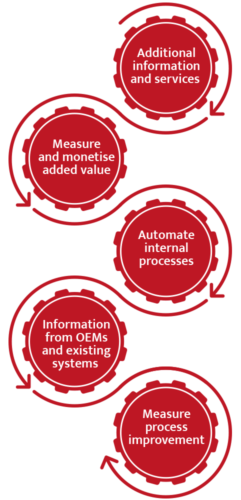Asset Performance Management at Every Level
Aligning your finance, sales and operations teams is as central to building a successful Asset Performance Management strategy as having the right tools.
To be successful with APM, there must be alignment on:
• What additional information and services would improve our customers’ efficiency and sustainability?
• How do we measure and, if appropriate, monetise the added value we are delivering to customers?
• What internal processes can we automate with APM technology?
• How can we measure internal process improvement?
• What information can our OEMs and existing systems provide us to support both customer and internal drivers?
At each level, your finance, sales and operations team must work together to identify and prioritise delivery of the external and internal process improvements that APM must deliver.
The team should also benchmark the existing process and track the additional revenue delivered and savings gained from implementing APM.

Coming together with APM
To operate APM seamlessly and achieve shared goals, everyone must take an organisation-wide approach to manage assets. Below is an example of how a company can come together with APM:
| Chief Financial Officer | Head of Sales |
For you, identifying the customer segments and key customers you want to target is the first step to introducing APM. You want to choose the most profitable customers that would benefit from the additional services APM will unlock. To identify the key customers, you will need to work with your Head of Sales. You will also want to explore how to monetise these services and discuss pricing with customers before firming up with the sales team. You will work with your Sales Managers to ensure the APM benefits are identified and communicated to customers and prospects. And you will put in place sales and revenue metrics to track engagement with new APM services You will also want to support your operations team in setting goals for internal process improvements enabled by introducing APM. | Now that you and your CFO have agreed on the key customers, you must interview their senior management to understand where APM can add the most value. Features like auto-alerting when CO2 levels are breached, or equipment is being incorrectly used will help you stand out from the competition. Once customer feedback has been collected and assessed, you will share your findings with the CFO and COO. Based on this feedback, you will select the new services you want to prioritise for launch on the APM platform. You will then train your sales team in the benefits of APM to customers and prospects. Finally, you will organise training on the APM platform to ensure your salesforce can showcase the benefits of your APM capability and differentiate your services. |
| Chief Operating Officer | Head of Sales |
You and the CFO will agree on the new customer services and internal process improvements you expect from implementing APM. You must Identify key subject matter experts to champion the APM solution implementation and input to develop expert rules. You must also identify technical contacts within your Equipment and Rental System providers. These contacts will be essential for the APM provider to connect telematics and operational data into their platform. | Now that you and the CFO have set clear goals for internal process improvement, you must prioritise the APM features you want to implement. Features such as auto-receipt, preventative and predictive maintenance and maintenance campaigns will all help automate and streamline your logistics and service processes. You must now ensure training and support processes are in place for all workers affected by the introduction of APM. For example, logistics planners, maintenance experts and customer service staff will all interact with the system at some point in their daily tasks. |
This blog is an excerpt from our “Guide to Asset Performance Management for Equipment Rental“.
Download the complete guide for more insights, such as “What is Asset Performance Management in Equipment Rental“.
Tags: APM, Equipment Rental